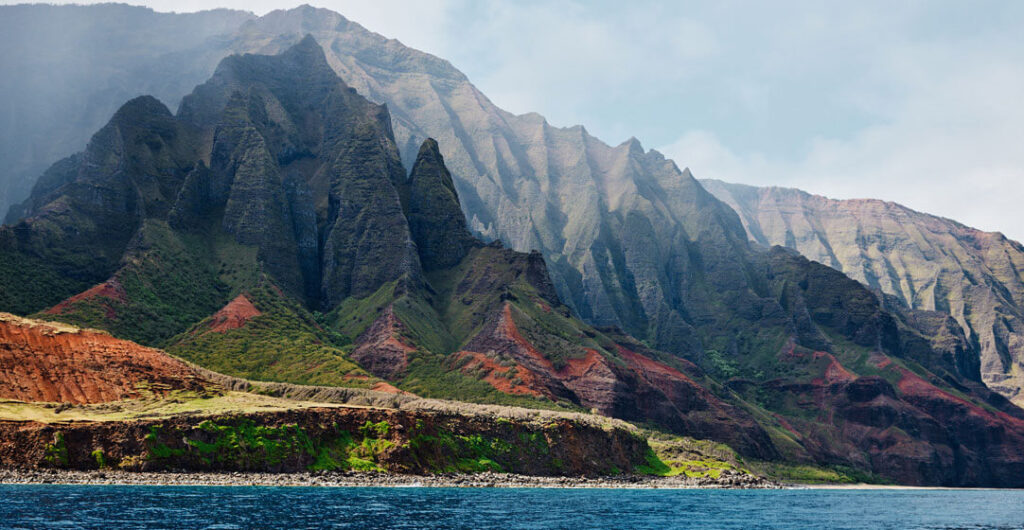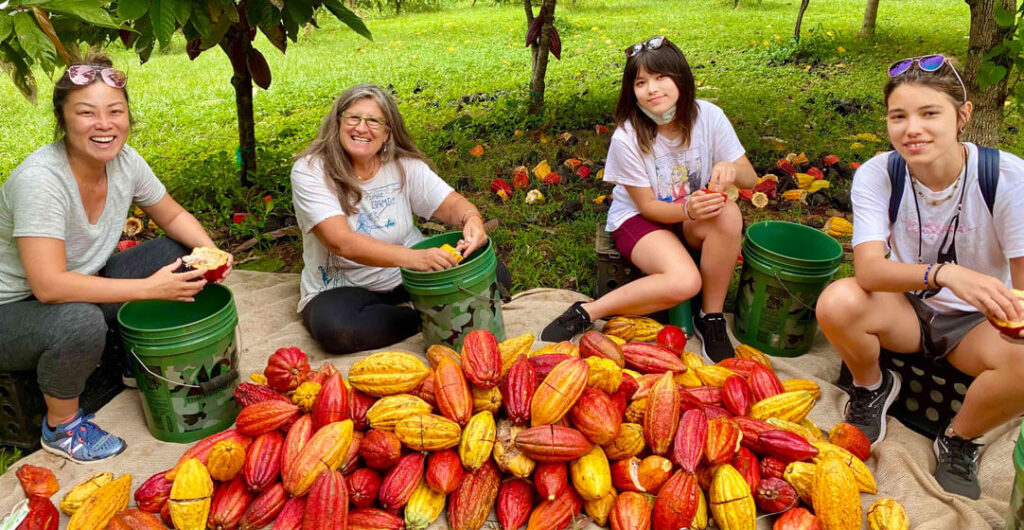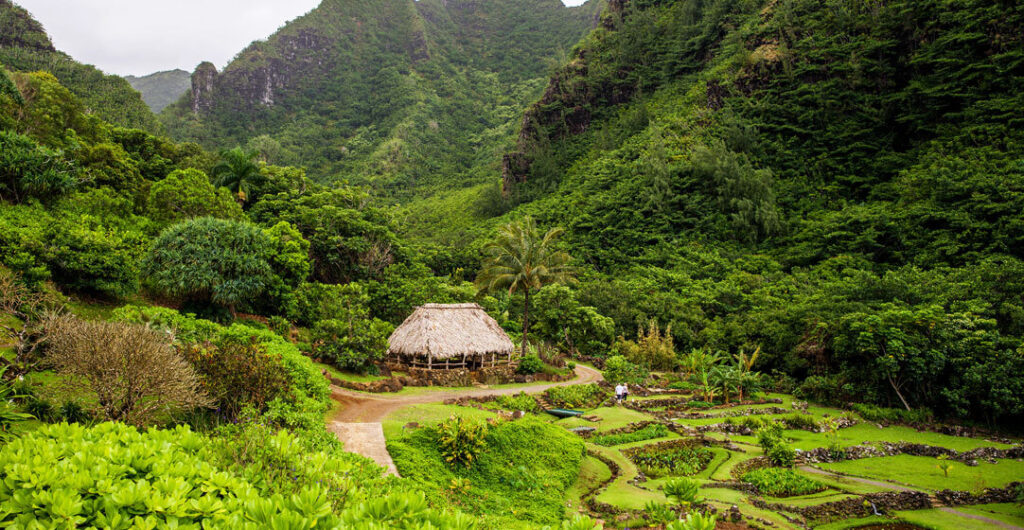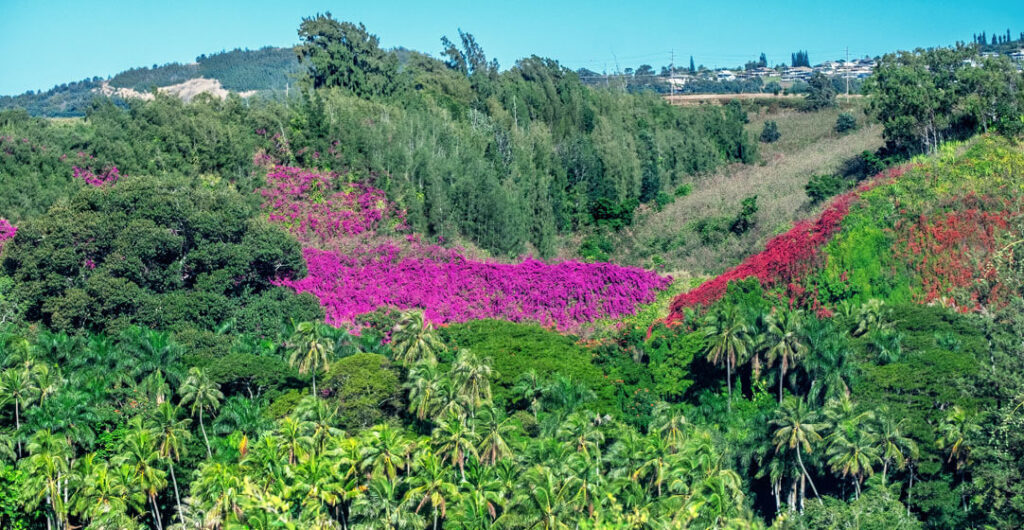See the garden island of Hawai‘i
For an obsessive gardener, it took me a long time to visit Kaua‘i, the verdant Hawaiian island famous for its lush forests and cultivated estates. Blame it on a desire to secure sun and sand for my Hawaiian holiday, forcing me to bypass a lush geography that includes Mount Wai’ale’ale, which is described locally as one of wettest place on earth. When I finally arrived this fall I encountered very little rainfall over several days but flowers everywhere.
I started my visit to Kaua‘i like I try to begin every day, with chocolate. I scheduled a farm tour at the Lydgate Farms, one of the only cacao plantations in the U.S. Cacao beans only grow within 20 degrees of the equator, which notches Hawai‘i on the northern tip of the “Chocolate Belt.”

I’ve attended more winery tours than I can remember but this is my first craft chocolate tasting. I was immediately struck by the similarities with winemaking, the importance of terroir, the bean varietals and the artisan’s patience — newly planted cacao trees take four to five years to bear fruit. In terms of the complexity of the process, however, chocolate takes the proverbial lava cake.
Football-sized pods that contain about 50 beans are harvested by hand. The seeds are cleaned, covered with banana leaves and fermented for several days, followed by at least six days of drying. They’re then roasted to crack and winnow the hulls to extract the nib. Finally, the chocolate magic begins.

Garden World
The Lydgate Farm Tour took us through the estate, introducing tropical plants like starfruit, vanilla and others. In addition to tasting a wide variety of chocolate types, I sipped cacao shell tea, a delicate blend that aids altitude sickness, stomach upset and several other maladies. And like red wine’s alchemy, cacao teems with reputed health-giving nutrients, lowering blood pressure and supplying antioxidants.
While cacao isn’t native to the island, Kaua‘i maintains the largest number of single-island endemic plants, 255 by the most recent count conducted by botanists at the National Tropical Botanical Garden. Of these, half are threatened by extinction, either from historic “canoe plants” brought by Polynesian traders or more recent invasives like Miconia, a favorite houseplant on the continent but a noxious weed here.

Scanning the lush mountains of Kaua‘i, their peaks scaled with dragon-green vegetation, it was hard to envision a barren landscape on this, the oldest island in the archipelago. Over time plants colonized the island via wind, sea and bird droppings, clinging first to the basalt and then thriving in the moisture-laden trade winds. The island was largely formed by flows of its extinct central shield volcano that also produced distinct microclimates and tremendous ecological diversity in a relatively small space.
Kaua‘i’s vegetative diversity is on full display at the Limahuli Garden and Preserve, located near the entrance of Ha‘ena State Park on the north side of the island. Polynesians settled in Limahuli Valley before 1000 A.D. They brought edible plants like breadfruit, sugarcane and taro, the latter grown in terraced ponds that still front the garden today.

The plantation-era garden also includes the more familiar pineapple, mango and gardenia. Many colored orchid species, as well as bird of paradise, symbols of modern Hawaii, were brought here. Not only have they thrived, their success has served to displace many native species.
Limahuli Garden & Preserve is managed by the National Tropical Botanical Garden (NTBG), a Kaua‘i-based organization dedicated to the study and preservation of tropical plants throughout the world. The Native Forest Walk at Limahuli Garden provides the finest collection of endemic species in Kaua‘i.
Gardens by Artists
To a plant lover, a walk among these native species compares to what a tour through the Louvre must feel like for a painter or a stroll around Florence might for an architect. Here you’ll find the Loulu, a palm with fan-shaped leaves that is native to Hawai‘i. The endemic pāpala, an amaranth, was burned as part of the õahi ceremony, a fire-throwing display from atop the soaring peak Makana Mountain. The hollow pāpala is light enough to float on the updraft, making a spectacular display from the sacred launch site.
A few hours spent strolling the Limahuli Garden & Preserve left me with an impression of Kaua‘i’s delicate ecosystems and similarly vulnerable landscapes in the Amazon and elsewhere across the world.
I was still thinking about the delicate position of endemic plants the following morning when I arrived at Na ‘Āina Kai Botanical Gardens & Sculpture Park. Here we were at the whimsey of Joyce Doty, who began designing this 240-acre property in the 1970s. What began as a private estate “backyard” featuring a large maze, lagoon and teahouse evolved into a fantastical display of realistic sculptures and botanical musings.

I was not sure what to make of the property, home to dozens of Norman Rockwell-style life-size bronze displays and numerous vegetative “galleries.” I was drawn to the Japanese garden, nested atop a knoll facing the lagoon with a gorgeous tea house.
Like Na ‘Āina Kai, the Allerton Garden began as a botanical blueprint for new residents drawn by the notion that just about any specimen planted in this environment would thrive. Robert Allerton and adopted son, John Gregg, paused in Kaua‘i as they concluded a plant-collecting expedition to Southeast Asia and the Pacific. Smitten, they purchased the property in the late 1930s from Alexander McBride, creator of the adjacent McBride Garden and, together with garden superintendent, Lawa‘i Valley native Hideo Teshima, crafted an impressive mosaic of distinct gardens.

Teshima began working here at age 14, and later became superintendent of the garden until his death in 2001. His influence is especially visible in the many water features, including a beautiful water trickle set against a natural rock edifice and framed by dangling ferns. (I made a note to borrow from this design by adding hanging ferns to my own water feature back in Seattle.)
Otherwordly Sights
Allerton Garden is divided into four distinct collections, but a juxtaposition of classical sculpture and Polynesian plantings predominate. Of course, one can’t help but pause at the massively rooted Moreton Bay fig trees, their buttress roots extending several feet in such an otherworldly manner. They were used as the setting for actor Sam Neill’s empty dinosaur egg discovery in “Jurassic Park.”

Allerton Garden serves as much more than a movie set, the diverse plantings offer researchers at the National Tropical Botanical Garden, which manages the property, to study threatened species. NTBG also offers several educational opportunities for professionals and amateurs who wish to learn more about tropical plant conservation.
I left no time for classes but I did reserve a few hours for a walk along the Kuilau Ridge Trail, a 4-mile roundtrip that unveils views of Mount Wai‘ale‘ale and the Makeleha Range. The two-hour hike conveys me along the ridgeline and into heavily forested terrain where the epiphytes, those fascinating, rootless piggybacking plants and several massive cycads, among the oldest plants on earth, fill the air and dominate the understory respectively.
The next morning, I departed Kaua‘i with a greater appreciation that every greenspace, be it cultivated or natural, has something to teach the gardener.
—Written by Crai S. Bower

Travel Planning Tips
Get expert advice: Your perfect getaway awaits. No matter what destination you choose, or how you wish to travel, AAA Travel experts can help you plan a perfect experience that you will remember for years to come.
Purchase travel insurance: Protect your trip investment with travel insurance.
Consider Concierge: AAA’s Concierge Vacations feature done-for-you details and special amenities for travel to world-wide destinations. AAA Travel Agents will make your planning a breeze and your vacation unforgettable.
On the road: Get ready for every trip with a AAA Membership. Get peace-of-mind on the road and much more.
Save with discounts: AAA membership gives you access to exclusive discounts nationwide.









